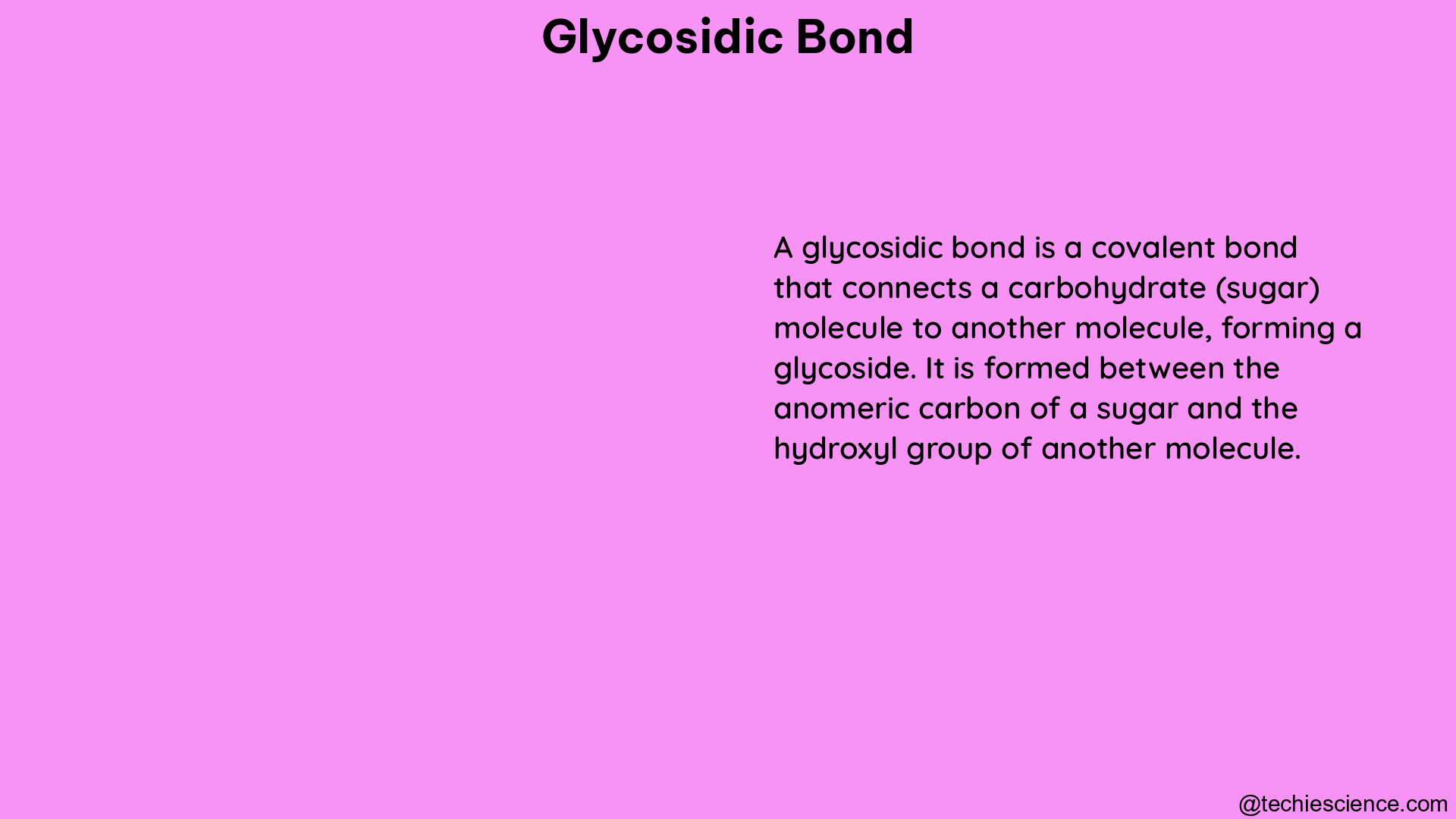The glycosidic bond is a fundamental structural feature of carbohydrates, playing a crucial role in the formation of disaccharides and polysaccharides. This covalent bond links two monosaccharide units, creating a diverse array of complex carbohydrate structures with a wide range of biological functions.
Understanding the Glycosidic Bond Formation
The glycosidic bond is formed between the anomeric carbon (the carbon atom that was previously bound to the carbonyl group in the open-chain form of the monosaccharide) of one monosaccharide and a hydroxyl group on another monosaccharide. This process results in the creation of a new glycosidic bond, which can be classified based on the position and configuration of the carbon atoms involved.
Glycosidic Bond Classification
- Position-based Classification:
- 1-2 glycosidic bond: Formed between the anomeric carbon (C1) of one monosaccharide and the second carbon atom (C2) of another monosaccharide.
- 1-3 glycosidic bond: Formed between the anomeric carbon (C1) of one monosaccharide and the third carbon atom (C3) of another monosaccharide.
- 1-4 glycosidic bond: Formed between the anomeric carbon (C1) of one monosaccharide and the fourth carbon atom (C4) of another monosaccharide.
-
1-6 glycosidic bond: Formed between the anomeric carbon (C1) of one monosaccharide and the sixth carbon atom (C6) of another monosaccharide.
-
Configuration-based Classification:
- α-glycosidic bond: The anomeric carbon has an α-configuration, where the hydroxyl group is in the axial position.
- β-glycosidic bond: The anomeric carbon has a β-configuration, where the hydroxyl group is in the equatorial position.
Structural Implications of Glycosidic Bonds
The formation of glycosidic bonds has significant implications for the structure and function of polysaccharides. The type and position of the glycosidic bond determine the shape and flexibility of the polysaccharide chain, which in turn affects its ability to interact with other molecules, such as enzymes and proteins. This structural diversity is crucial for the diverse biological roles of carbohydrates, including energy storage, structural support, and cell-cell recognition.
Quantifying the Glycosidic Bond

The glycosidic bond can be characterized and quantified using various measures, including bond energy and hydrolysis rate.
Bond Energy
The bond energy of a glycosidic bond is the amount of energy required to break the bond. This energy value depends on several factors, such as the type of monosaccharides involved, the position of the bond, and the configuration of the anomeric carbon.
For example, the bond energy of a 1-4 glycosidic bond between two glucose molecules is approximately 3.4 kcal/mol, while the bond energy of a 1-6 glycosidic bond between two glucose molecules is approximately 2.9 kcal/mol.
Hydrolysis Rate
The hydrolysis of a glycosidic bond involves the use of water to break the bond. The rate of hydrolysis depends on various factors, including the type of glycosidic bond, the pH and temperature of the solution, and the presence of enzymes or other catalysts.
Generally, the rate of hydrolysis for a 1-4 glycosidic bond between two glucose molecules is faster than that of a 1-6 glycosidic bond between two glucose molecules. This is due to the differences in the accessibility and stability of the respective glycosidic bonds.
Structural Characterization of Glycosidic Bonds
In addition to the quantitative measures, the glycosidic bond can also be characterized by its structural features, such as the type and position of the monosaccharides involved, the configuration of the anomeric carbon, and the presence of any substituents or modifications.
These structural features can be determined using various analytical techniques, including:
-
Nuclear Magnetic Resonance (NMR) Spectroscopy: NMR spectroscopy can provide detailed information about the chemical environment and connectivity of the atoms within the glycosidic bond, allowing for the identification of the monosaccharides and the configuration of the anomeric carbon.
-
Mass Spectrometry: Mass spectrometry can be used to determine the molecular weight and fragmentation patterns of glycosidic bonds, providing insights into the composition and structure of the carbohydrate molecules.
-
Chromatography: Techniques like high-performance liquid chromatography (HPLC) and gas chromatography (GC) can be used to separate and analyze the different components of a carbohydrate mixture, including the identification of the glycosidic bonds present.
By combining these analytical techniques, researchers can gain a comprehensive understanding of the structural features and properties of glycosidic bonds, which is crucial for elucidating the biological functions and applications of carbohydrates.
Conclusion
The glycosidic bond is a fundamental structural feature of carbohydrates, playing a crucial role in the formation of disaccharides and polysaccharides. This covalent bond can be classified based on the position and configuration of the carbon atoms involved, and it has significant implications for the structure and function of polysaccharides.
The glycosidic bond can be quantified by its bond energy and hydrolysis rate, and its structural features can be characterized using various analytical techniques, such as NMR spectroscopy, mass spectrometry, and chromatography. Understanding the properties and characteristics of the glycosidic bond is essential for understanding the diverse biological roles of carbohydrates and their potential applications in various fields, including medicine, biotechnology, and materials science.
References:
– How to Form a Glycosidic Bond between Two Sugars – YouTube. Available at: https://www.youtube.com/watch?v=kc_q062Ajcs
– Course-Notes.Org. Available at: https://course-notes.org/node?page=2274
– Glycosidic Bond – an overview | ScienceDirect Topics. Available at: https://www.sciencedirect.com/topics/engineering/glycosidic-bond
– Glycosidic Linkage – an overview | ScienceDirect Topics. Available at: https://www.sciencedirect.com/topics/chemistry/glycosidic-linkage
– 1 Abbreviated Title: DAC-THU/Pembro: NSCLC, EsC, PM Version Date: 08/01/2022. Available at: https://www.clinicaltrials.gov/ProvidedDocs/24/NCT03233724/Prot_SAP_000.pdf

The lambdageeks.com Core SME Team is a group of experienced subject matter experts from diverse scientific and technical fields including Physics, Chemistry, Technology,Electronics & Electrical Engineering, Automotive, Mechanical Engineering. Our team collaborates to create high-quality, well-researched articles on a wide range of science and technology topics for the lambdageeks.com website.
All Our Senior SME are having more than 7 Years of experience in the respective fields . They are either Working Industry Professionals or assocaited With different Universities. Refer Our Authors Page to get to know About our Core SMEs.